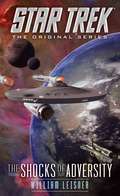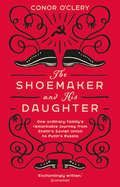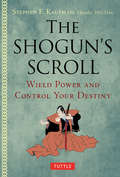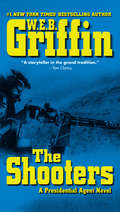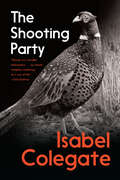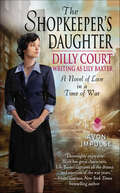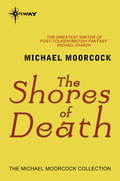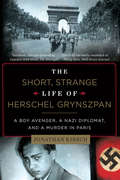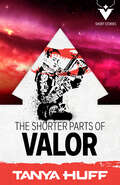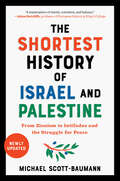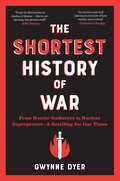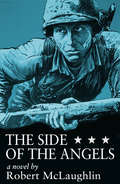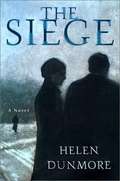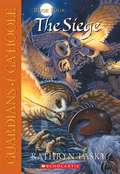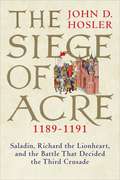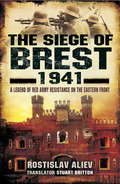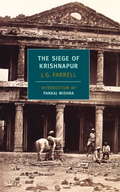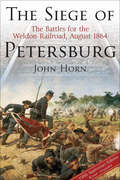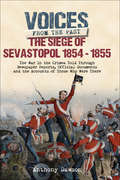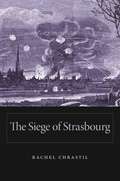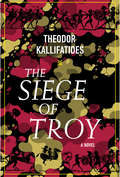- Table View
- List View
The Shocks of Adversity: The Shocks of Adversity (Star Trek: The Original Series)
by William LeisnerAn original novel set in the universe of Star Trek: The Original Series!Located far beyond the boundaries of explored space, the Goeg Domain is a political union of dozens of planets and races. When the U.S.S. Enterprise arrives in its territory to investigate an interstellar phenomenon, Commander Laspas of the Domain Defense Corps is at first guarded, then fascinated to discover the existence of an alliance of worlds much like his own, and finds a kindred spirit in Captain James T. Kirk. And when the Enterprise is attacked by the Domain’s enemies, crippling the starship’s warp capability and leaving its crew facing the prospect of a slow, months-long journey home, the Goeg leader volunteers the help of his own ship, offering to combine the resources of both vessels to bring the Enterprise to a nearby Domain facility to make the necessary repairs. But what at first seems to be an act of peace and friendship soon turns out to be a devil’s bargain, as Kirk and the Enterprise crew learn that there are perhaps more differences than similarities between the Federation and the Domain. When the Goeg’s adversaries strike again, the Enterprise is drawn deeper and inexorably into the conflict, and Kirk begins to realize that they may have allied themselves with the wrong side....
The Shoemaker and his Daughter
by Conor O'CleryWINNER OF THE 2020 MICHEL DÉON PRIZE'O'Clery takes us into the hidden heart of Soviet Russia... An arresting and evocative story' Keggie Carew, author of Dadland'A tour de force ... Love, politics, murder, wars, and the fracturing of ties, personal and ethnic. O'Clery is a gifted writer' Luke Harding, bestselling author of CollusionThe Soviet Union, 1962. Gifted shoemaker Stanislav Suvorov is imprisoned for five years. His crime? Selling his car for a profit. On his release, social shame drives him and his family into voluntary exile in Siberia, 5,000 kilometres from home. In a climate that's unfriendly both geographically and politically, it's their chance to start again. The Shoemaker and His Daughter is an epic story spanning the Second World War to the fall of the Soviet Union, taking in eighty years of Soviet and Russian history, from Stalin to Putin. Following the footsteps of a remarkable family Conor O'Clery knows well - he is married to the shoemaker's daughter - it's both a compelling insight into life in a secretive world at a siesmic moment in time and a powerful tale of ordinary lives shaped by extraordinary times.
The Shogun's Scroll
by Stephen F. KaufmanIn the tradition of The Art of War and The Book of Five Rings, Stephen Kaufman's The Shogun's Scroll offer timeless advice on success in war and life. Written in the voice of Hidetomo Nakadai, a late twelfth century scholar and servant in the court of Minamoto Yoritomo-the first shogun of Japan and one of the world's most ruthless generals-this treatise can be used as a guide for personal development and motivation.
The Shogun's Scroll
by Stephen F. KaufmanThe Shogun's Scroll offers a look at the samurai strategies and ethics of medieval Japan distilled into language modern readers can relate to and follow.In the tradition of The Art of War and The Book of Five Rings, this book offers timeless advice on success in war and life. Written in the voice of Hidetomo Nakadai, a late twelfth century scholar and servant in the court of Minamoto Yoritomo--the first shogun of Japan and one of the world's most ruthless generals--this treatise can be used as a guide for personal growth and motivation.The author draws on a lifetime of intimate personal experiences with the philosophy of Japanese martial arts as well as countless historical sources to produce this profound work of docu-fiction. It is essential reading for those interested in martial arts, samurai, military history or Japanese history.
The Shooters (Presidential Agent #4)
by W.E.B. GriffinNow, still in Argentina tying up loose ends from his investigation into the UN oil-for-food scandal, Castillo is startled when a young man is marched into his office at gunpoint, caught trying to sneak through the fence. It turns out he's an American officer, a lieutenant assigned to the embassy in Paraguay. A key agent for the DEA has disappeared while trying to interdict drugs and very little is being done about it, for phony diplomatic reasons. The lieutenant's heard of Castillo, knows what he's done, and wants his help in getting the agent back. More than that, he's got an innovative plan for dealing with the drug lords themselves. Intrigued, Castillo gets permission to try it, but the President has just one warning for him: Don't get caught. Charley couldn't agree more-but it might turn out to be something easier said than done. . . .
The Shooting Party: A Novel
by Isabel ColegateA leisurely weekend among the British gentry reveals the cracks in their upper-class society in this &“beautifully crafted&” historical fiction novel set in pre-WWI England (Washington Post).&“A lovely piece of writing, in which subtlety, irony, and close observation abound.&” —Larry McMurtryIt is the autumn of 1913. Sir Randolph Nettleby has assembled a brilliant array of guests at his Oxfordshire estate for the biggest hunt of the season. An army of gamekeepers, beaters, and servants has rehearsed the intricate age–old ritual, the gentlemen are falling into the prescribed mode of fellowship and sporting rivalry, the ladies intrigued by the latest gossip and fashion. Everything about this splendid weekend would seem a perfect consummation of the pleasures afforded the privileged in Edwardian England. And yet it is not: the moral and social code of this group is not so secure as it appears. Competition beyond the bounds of sportsmanship, revulsion at the slaughter of the animals, anger at the inequities of class—these forces are about to rise up and engulf the assured social peace, a peace that can last only a brief while longer. In imagining Sir Randolph's shooting party, wrote The Spectator, Miss Colegate has found a perfect metaphor for the passing of a way of life.
The Shop Girl's Soldier: A heart-warming family saga set during WWI and WWII
by Karen DicksonAS WAR APPROACHES, WILL HER LOVE GUIDE HIM HOME?&‘An exciting, fresh and talented new voice – a five-star read!&’ CAROL RIVERS, author of Molly&’s Christmas Orphans Southampton, 1905. Ellie-May and Jack have been inseparable since birth. They are best friends, having grown up together on the same street. But when Jack and his mother fall on hard times they are thrown into the workhouse, and he and Ellie-May are forced into a goodbye. Four years later, now aged sixteen, Jack returns to Southampton and is reunited with Ellie-May. Quickly they both realise that their feelings for each other go beyond friendship, and with Jack home for good the pair are finally free to be together. But when WWII approaches, Jack&’s duty to his country is hard to ignore and when he enlists to fight, they are once again torn apart. Will Ellie-May and Jack find their way back to each other before it&’s too late? A brand new wartime family saga, perfect for fans of Rosie Goodwin and Val Wood
The Shopkeeper's Daughter
by Lily Baxter Dilly CourtIn World War II–torn England, a young woman must fight to keep her family together, whatever the costGinnie Travis has been working in her father's shop for the past five years, trying to keep it afloat. When scandal rocks her family just as relentless Nazi raids threaten their very lives, Ginnie and her sister are forced to flee and stay with their aunt in the North of England. The last thing she expects to find in the quiet countryside is love, especially with an American soldier. A soldier who has secrets of his own.Tragedy strikes, the horror of war rages on, and Ginnie will do whatever she must to protect everything she holds dear.
The Shopkeeper’s Daughter
by Lily BaxterJune 1944. Ginnie Travis is working in her father's furniture shop, when the continued bombing raids and her sister Shirley's untimely pregnancy force the two girls to go and stay with their aunt in Shropshire. Here Ginnie falls in love with an American, Lieutenant Nick Miller, stationed nearby. But she discovers that Nick has a fiancée back home and a heartbroken Ginnie ends the relationship. Then news of their father's death in an air raid reaches them. With the family left almost penniless and Shirley and her child to provide for, Ginnie is responsible for them all. And when the shop comes under threat, she is even more determined to make it succeed and build a new life for herself and her family.
The Shores of Death
by Michael MoorcockWith Earth teetering on the brink of extinction, only one man dares to defy the legacy of the Spaceraiders - Clovis Marca, the twilight man.Long ago Earth, now fixed on her axis, with eternal day on one side, eternal night on the other and a ribbon of twilight in between, was ravaged by galactic raiders. Earthlings recovered, grew stronger. But now, unable to reproduce, the last humans are frenzied with final decadence. And fear.Only Clovis Marca, the last man born on Earth, dares to brave infected space to seek the impossible solution. His dark quest leads him to face Orlando Sharvis, the scientist whose insane experiments on his own mind and body might just save the human race... but would that race then be more, or less, human?
The Short Story and the First World War
by Ann-Marie EinhausThe poetry of the First World War has come to dominate our understanding of its literature, while genres such as the short story, which are just as vital to the literary heritage of the era, have largely been neglected. In this study, Ann-Marie Einhaus challenges deeply embedded cultural conceptions about the literature of the First World War using a corpus of several hundred short stories that, until now, have not undergone any systematic critical analysis. From early wartime stories to late twentieth-century narratives - and spanning a wide spectrum of literary styles and movements - Einhaus's work reveals a range of responses to the war through fiction, from pacifism to militarism. Going beyond the household names of Owen, Sassoon, and Graves, Einhaus offers scholars and students unprecedented access to new frontiers in twentieth-century literary studies.
The Short, Strange Life of Herschel Grynszpan: A Boy Avenger, a Nazi Diplomat, and a Murder in Paris
by Jonathan Kirsch"Reading this excellent, thought-provoking biography, one is all too easily reminded of Camus's 1942 novel, The Stranger."--Philip Kerr, Wall Street Journal On the morning of November 7, 1938, Herschel Grynszpan, a desperate seventeen-year-old Jewish refugee, walked into the German embassy in Paris and shot Ernst vom Rath, a Nazi diplomat. Two days later vom Rath lay dead, and the Third Reich exploited the murder to unleash Kristallnacht in a bizarre concatenation of events that would rapidly involve Ribbentrop, Goebbels, and Hitler himself. But was Grynszpan a crazed lone gunman or agent provocateur of the Gestapo? Was he motivated by a desire to avenge Jewish people, or did his act of violence speak to an intimate connection between the assassin and his target, as Grynszpan later claimed? Part page-turning historical thriller and part Kafkaesque legal drama, The Short, Strange Life of Herschel Grynszpan brings to life the historical details and moral dimensions of one of the most enigmatic cases of World War II. This compelling biography presents a story with twists and turns that "no novelist could invent" (Alice Kaplan).
The Shorter Parts of Valor (Confederation of Valor)
by Tanya HuffA collection of stories from bestselling author Tanya Huff’s Confederation universe, including both previously published and never-before-seen works, and the author’s own wry and insightful commentary. Read on for stories featuring• Torin Kerr’s not-quite-standard field promotion to sergeant—just in time to lead a recon team through a captured planet with a secret…• A grueling struggle fought from low-tech battlements and city walls, where Torin’s lieutenant has a dangerous taste for heroics…• A glimpse under the head plates of Heavy Gunner Deena Harmin, who finds her squad pinned down behind enemy lines and must push the boundaries between human and machine to give them a chance… • A colony facing unnatural ruin, where Torin Kerr must choose what to believe—and what to report…• Torin, Werst, Ressk, and the rest of the team following the third Peacekeeper book, where the crew faces down a ship that looks like Big Yellow, but heralds a new and even more surprising sentient encounter…Brimming with Huff’s signature mix of grit, loyalty, and enough daring to move planets, each story presents a new window into a universe beloved of thousands, where courage and quick thinking make the difference between survival—and disaster.
The Shortest History of Israel and Palestine: From Zionism To Intifadas And The Struggle For Peace (Shortest History #0)
by Michael Scott-BaumannAn accessible chronicle of how the Israel-Palestine conflict originated and developed over the past century. The Shortest History books deliver thousands of years of history in one riveting, fast-paced read. The ongoing struggle between Israel and Palestine is one of the most bitter conflicts in history, with profound global consequences. In this book, Middle East expert Michael Scott-Baumann succinctly describes its origins and charts its evolution from civil war to the present day. Each chapter offers a lucid explanation of the politics and ends with personal testimony from Palestinians and Israelis whose lives have been impacted by the dispute. While presenting competing interpretations, Scott-Baumann examines the key flash points, including the early role of the British, the establishment of the state of Israel in 1948, the Six-Day War of 1967, and the Trump administration’s peace plan, pitched as “the deal of the century,” in 2020. He delineates both the nature of Israeli control over the Palestinian territories and Palestinian resistance—going to the heart of the clashes in recent decades. The result is an indispensable history, including a time line, glossary, and analysis of why efforts to restore peace have continually failed and what it will take to succeed.
The Shortest History of War: From Hunter-gatherers To Nuclear Superpowers--a Retelling For Our Times (Shortest History #0)
by Gwynne DyerA brisk account of this defining feature of human society, from prehistory to nuclear proliferation and lethal autonomous weapons. The Shortest History books deliver thousands of years of history in one riveting, fast-paced read. War has changed, but we have not. From our hunter-gatherer ancestors to the rival nuclear powers of today, whenever resources have been contested, we’ve gone to battle. Acclaimed historian Gwynne Dyer illuminates our many martial clashes in this brisk account, tracing warfare from prehistory to the world’s first cities—and on to the thousand-year “classical age” of combat, which ended when the firearm changed everything. He examines the brief interlude of “limited war” before eighteenth-century revolution ushered in “total war”—and how the devastation was halted by the nuclear shock of Hiroshima. Then came the Cold War and Russia’s invasion of Ukraine, which punctured the longest stretch of peace between major powers since World War II. For all our advanced technology and hyperconnected global society, we find ourselves once again on the brink as climate change heightens competition for resources and superpowers stand ready with atomic bombs, drones, and futuristic “autonomous” weapons in development. Throughout, Dyer delves into anthropology, psychology, and other relevant fields to unmask the drivers of conflict. The Shortest History of War is for anyone who wants to understand the role of war in the human story—and how we can prevent it from defining our future.
The Side of the Angels
by Robert McLaughlinThe Side of the Angels, first published in 1947, is a novel set in World War II centering on two brothers: Tom Egan and his older brother Clark. Tom, a private in the U.S. Army, sails for Italy and takes part in the landings at Salerno. Clark, also in Italy, serves in the OSS. The brothers’ experiences - Tom is wounded and Clark escapes death during a German air-raid - and differing viewpoints drive them apart, and their differences grow upon their return to America. The Side of the Angels is compelling for its warm, sensitive portrayal of the characters within the broader scope of the war. Author Robert McLaughlin (1908-1973) was a journalist and editor of Time magazine for more than 20 years. He served in the U.S. Army during World War II. In addition to writing three novels, he published numerous short stories. The Side of the Angels was his first novel.
The Siege
by Helen Dunmore1941; Leningrad is under siege by the German army and the relentless winter. Thousands will starve or freeze before spring. This story details the effects on ordinary people.
The Siege (Guardians of Ga'Hoole #4)
by Kathryn LaskyEnraged by his clash with Soren and driven by and all-consuming desire for power, Kludd and his group, the Pure Ones, launch an attack upon the Great Ga'Hoole Tree. The noble owls who live there must fight fiercely to protect their resources and defend their honor.
The Siege of Acre, 1189-1191: Saladin, Richard the Lionheart, and the Battle That Decided the Third Crusade
by John D. HoslerThe first comprehensive history of the most decisive military campaign of the Third Crusade and one of the longest wartime sieges of the Middle Ages The two-year-long siege of Acre (1189–1191) was the most significant military engagement of the Third Crusade, attracting armies from across Europe, Syria, Mesopotamia, Egypt, and the Maghreb. Drawing on a balanced selection of Christian and Muslim sources, historian John D. Hosler has written the first book-length account of this hard-won victory for the Crusaders, when England’s Richard the Lionheart and King Philip Augustus of France joined forces to defeat the Egyptian Sultan Saladin. Hosler’s lively and engrossing narrative integrates military, political, and religious themes and developments, offers new perspectives on the generals, and provides a full analysis of the tactical, strategic, organizational, and technological aspects on both sides of the conflict. It is the epic story of a monumental confrontation that was the centerpiece of a Holy War in which many thousands fought and died in the name of Christ or Allah.
The Siege of Brest, 1941: A Legend of Red Army Resistance on the Eastern Front
by Rostislav AlievA Russian historian recounts the legendary Soviet defense of Brest against Nazi invasion in this lively and authoritative WWII chronicle. On June 22nd, 1941, Hitler&’s Operation Barbarossa began with the Nazi attack on the Soviet frontier fortress of Brest. Across a massive front stretching from the Baltic to the Black Sea, the German forces advanced, taking the Red Army by surprise and brushing aside the first stunned defenses. But the isolated stronghold of Brest held out. The defenders, trapped and without hope of relief, put up a tenacious resistance against an entire Wehrmacht division as the Soviet front collapsed behind them. The heroic defense of Brest has become one of the legends of the Second World War on the Eastern Front, an example of selfless Soviet heroism in the face of Nazi aggression. Rostislav Aliev describes the fighting, hour by hour, in vivid detail. In the process, he strips away the myths and exaggerations that have grown up around this famous story. Using eyewitness testimony and extensive research, Aliev reconstructs each stage of the siege. From the shock of the initial artillery barrage, he describes the defenders&’ chaotic struggle to organize resistance, their doomed counter-attacks, the continuous pounding of German guns and bombs, the grim fate of the Soviet survivors, and the extraordinary resistance of small groups of soldiers operating in the underground passages of the shattered fortress.
The Siege of Krishnapur
by J. G. FarrellIn the Spring of 1857, with India on the brink of a violent and bloody mutiny, Krishnapur is a remote town on the vast North Indian plain. For the British there, life is orderly and genteel. Then the sepoys at the nearest military cantonment rise in revolt and the British community retreats with shock into the Residency. They prepare to fight for their lives with what weapons they can muster. As food and ammunition grow short, the Residency, its defences battered by shot and shell and eroded by the rains, becomes ever more vulnerable. The Siege of Krishnapur is a modern classic of narrative excitement that also digs deep to explore some fundamental questions of civilisation and life. <P><P> Winner of the Man Booker Prize
The Siege of Petersburg: The Battles for the Weldon Railroad, August 1864
by John HornA revised and expanded tactical study General Grant’s Fourth Offensive during the American Civil War.The nine-month siege of Petersburg was the longest continuous operation of the American Civil War. A series of large-scale Union “offensives,” grand maneuvers that triggered some of the fiercest battles of the war, broke the monotony of static trench warfare. Grant’s Fourth Offensive, August 14–25, the longest and bloodiest operation of the campaign, is the subject of John Horn’s revised and updated Sesquicentennial edition of The Siege of Petersburg: The Battles for the Weldon Railroad, August 1864.Frustrated by his inability to break through the Southern front, General Grant devised a two-punch combination strategy to sever the crucial Weldon Railroad and stretch General Lee’s lines. The plan called for Winfield Hancock’s II Corps (with X Corps) to move against Deep Bottom north of the James River to occupy Confederate attention while Warren’s V Corps, supported by elements of IX Corps, marched south and west below Petersburg toward Globe Tavern on the Weldon Railroad. The move triggered the battles of Second Deep Bottom, Globe Tavern, and Second Reams Station, bitter fighting that witnessed fierce Confederate counterattacks and additional Union operations against the railroad before Grant’s troops dug in and secured their hold on Globe Tavern. The result was nearly 15,000 killed, wounded, and missing, the severing of the railroad, and the jump-off point for what would be Grant’s Fifth Offensive in late September.Revised and updated for this special edition, Horn’s outstanding tactical battle study emphasizes the context and consequences of every action and is supported by numerous maps and grounded in hundreds of primary sources. Unlike many battle accounts, Horn puts Grant’s Fourth Offensive into its proper perspective not only in the context of the Petersburg Campaign and the war, but in the context of the history of warfare.“A superior piece of Civil War scholarship.” —Edwin C. Bearss, former Chief Historian of the National Park Service and award-winning author of The Petersburg Campaign: Volume 1, The Eastern Front Battles and Volume 2, The Western Front Battles“It’s great to have John Horn’s fine study of August 1864 combat actions (Richmond-Petersburg style) back in print; covering actions on both sides of the James River, with sections on Deep Bottom, Globe Tavern, and Reams Station. Utilizing manuscript and published sources, Horn untangles a complicated tale of plans gone awry and soldiers unexpectedly thrust into harm’s way. This new edition upgrades the maps and adds some fresh material. Good battle detail, solid analysis, and strong characterizations make this a welcome addition to the Petersburg bookshelf.” —Noah Andre Trudeau, author of The Last Citadel: Petersburg, June 1864–April 1865
The Siege of Sevastopol, 1854–1855: The War in the Crimea Told Through Newspaper Reports, Official Documents and the Accounts of Those Who Were There (Voices from the Past)
by Anthony DawsonA history of the grueling Crimean War battle as told through personal accounts of those who fought there.The Crimean War, the most destructive and deadly war of the nineteenth century, has been the subject of countless books, yet historian Anthony Dawson has amassed an astonishing collection of previously unknown and unpublished material, including numerous letters and private journals. Many untapped French sources reveal aspects of the fighting in the Crimea that have never been portrayed before.The accounts demonstrate the suffering of the troops during the savage winter and the ravages of cholera and dysentery that resulted in the deaths of more than 16,000 British troops and 75,000 French. Whilst there is graphic first-hand testimony from those that fought up the slopes of the Alma, in the valley of death at Balaklava, and the fog of Inkerman, the book focusses upon the siege; the great artillery bombardments, the storming of the Redan and the Mamelon, and the largest man-made hole in history up to that time when the Russians blew up the defences they could not hold, with their own men inside.The Siege of Sevastopol also highlights, for the first time, the fourth major engagement in the Crimea, the Battle of the Tchernaya in August 1855, the Russians’ last great attempt to break the siege. This predominantly French-fought battle has never before examined in such in English language books.Praise for The Siege of Sevastopol, 1854–1855“In this fascinating book, the voices of men involved in the war in the Crimea are heard for the first time. Compelling and intriguing stuff.” —Books Monthly“The author has collected a large amount of previously unpublished material for this new work. Entries from private letters and journal are mixed with French sources previously unused in the English-speaking world. The result is a work that effectively conveys the thoughts and experiences of the participants to the reader.” —Warfare History Network
The Siege of Strasbourg
by Rachel ChrastilFor six terror-filled weeks in 1870 German armies bombarded Strasbourg, killing hundreds of citizens, wounding thousands, and destroying landmarks. Rachel Chrastil tells how the city became the epicenter of a new kind of warfare whose indiscriminate violence shocked contemporaries and led to debates over the wartime protection of civilians.
The Siege of Troy: A Novel
by Theodor KallifatidesIn this perceptive retelling of The Iliad, a young Greek teacher draws on the enduring power of myth to help her students cope with the terrors of Nazi occupation.Bombs fall over a Greek village during World War II, and a teacher takes her students to a cave for shelter. There she tells them about another war--when the Greeks besieged Troy. Day after day, she recounts how the Greeks suffer from thirst, heat, and homesickness, and how the opponents meet--army against army, man against man. Helmets are cleaved, heads fly, blood flows. And everything had begun when Prince Paris of Troy fell in love with King Menelaus of Sparta's wife, the beautiful Helen, and escaped with her to his homeland. Now Helen stands atop the city walls to witness the horrors set in motion by her flight. When her current and former loves face each other in battle, she knows that, whatever happens, she will be losing. Theodor Kallifatides provides remarkable psychological insight in his version of The Iliad, downplaying the role of the gods and delving into the mindsets of its mortal heroes. Homer's epic comes to life with a renewed urgency that allows us to experience events as though firsthand, and reveals timeless truths about the senselessness of war and what it means to be human.
